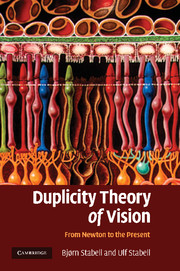Book contents
- Frontmatter
- Contents
- Acknowledgements
- 1 Introduction
- Part I The development of the basic ideas of the duplicity theory from Newton to G. E. Müller
- Part II The development of the duplicity theory from 1930–1966
- Part III Chromatic rod vision: a historical account
- Part IV Theories of sensitivity regulation of the rod and cone systems: a historical account
- 15 Introduction
- 16 Early photochemical explanations
- 17 Contribution of S. Hecht
- 18 Contribution of G. Wald: photochemical sensitivity regulation mechanisms of rods and cones
- 19 Relationship between amount of rhodopsin and sensitivity during dark adaptation
- 20 Post-receptor sensitivity regulation mechanisms
- 21 Rushton's AGC model
- 22 Contribution of H.B. Barlow
- 23 Rushton and Barlow compared
- 24 The Dowling-Rushton equation refuted
- 25 Several mechanisms involved in sensitivity regulation
- 26 Sensitivity regulation due to rod-cone interaction
- 27 Modern conceptions of sensitivity regulation
- Part V Factors that triggered the paradigm shifts in the development of the duplicity theory
- References
- Index
20 - Post-receptor sensitivity regulation mechanisms
Published online by Cambridge University Press: 22 January 2010
- Frontmatter
- Contents
- Acknowledgements
- 1 Introduction
- Part I The development of the basic ideas of the duplicity theory from Newton to G. E. Müller
- Part II The development of the duplicity theory from 1930–1966
- Part III Chromatic rod vision: a historical account
- Part IV Theories of sensitivity regulation of the rod and cone systems: a historical account
- 15 Introduction
- 16 Early photochemical explanations
- 17 Contribution of S. Hecht
- 18 Contribution of G. Wald: photochemical sensitivity regulation mechanisms of rods and cones
- 19 Relationship between amount of rhodopsin and sensitivity during dark adaptation
- 20 Post-receptor sensitivity regulation mechanisms
- 21 Rushton's AGC model
- 22 Contribution of H.B. Barlow
- 23 Rushton and Barlow compared
- 24 The Dowling-Rushton equation refuted
- 25 Several mechanisms involved in sensitivity regulation
- 26 Sensitivity regulation due to rod-cone interaction
- 27 Modern conceptions of sensitivity regulation
- Part V Factors that triggered the paradigm shifts in the development of the duplicity theory
- References
- Index
Summary
PSYCHOPHYSICAL EVIDENCE
The close relationship between amount of bleached photopigment and sensitivity obtained during long-term dark adaptation strongly indicated that the sensitivity regulation mechanisms were mainly located in the receptors. Both Hecht and Wald had accepted this basic assumption. Rushton (1965a, b), however, strongly opposed this view. Thus, he held that both the signals from bleached photopigments and the signals generated by background light regulated sensitivity centrally to the receptors in what he termed ‘an automatic gain control-summation pool’ (AGC pool). He based his position on two different lines of evidence.
Firstly, he found that a background light so weak that less than 10% of the rods could have caught a single quantum of light raised the threshold three-fold. Apparently, the 10% of the rod receptors that had received a single photon hit had markedly reduced the sensitivity of the 90% that were quite unaffected by the adapting light.
Secondly, Rushton (1965a) could provide strong supporting evidence in favour of his view by both light- and dark-adaptation experiments.
In the light-adaptation experiment, Rushton took advantage of an ingenious technique where he stabilized the light stimuli on the retina. The background was a black-red grating of period 0.5º (presumed to be less than the receptive field of the summation pool) and the test flash, a black-green similar size grating (presumed to activate rod receptors). The test flash superimposed on the background was alternately in- and out-phase.
- Type
- Chapter
- Information
- Duplicity Theory of VisionFrom Newton to the Present, pp. 157 - 159Publisher: Cambridge University PressPrint publication year: 2009



